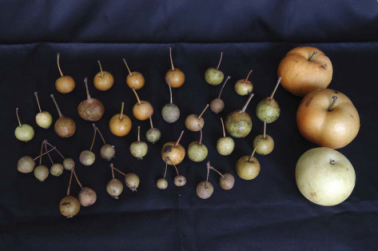MENU
The research field "Plant Germplasm Enhancement" is stationed in the Food Research Education and Research Center (hereinafter referred to as the Center). The Center is a field-oriented institution located in the central area of the Banshu Plains in Kasai City (approximately 60 km west of the Rokko-dai campus) and has 40 ha of land area. The Center features real-scale agricultural production carried out as a base for educational and research activities. Our research themes include exploring the origin and evolution of cultivated plants particularly of Japanese pear and rice, and investigating gene function and expression of useful agronomic traits for future breeding.

‘Iwate-yamanashi’ (Pyrus ussuriensis var. aromatica) is one of the Pyrus species grown in the wild and is now endangered in Japan. The origin of the Japanese pear (P. pyrifolia) is uncertain but it has been suggested that ‘Iwate-yamanashi’ is the possible progenitor of the modern Japanese pear. Its population size has been decreasing and therefore, conservation is urgently needed. A set of 650 trees including ‘Iwate-yamanashi’ have been conserved as a wild core pear germplasm collection at the Center. Population genetics approaches using morphological traits and DNA markers (simple sequence repeat markers and chloroplast DNA markers) revealed a wide range of genetic diversity inPyrus species. This diversity is caused, not only by high heterogeneity in ‘Iwate-yamanashi’ itself, but also by the coexistence of ‘Iwate-yamanashi’, P. pyrifolia and their hybrid progeny in the collected areas. Current interests are focused on the selection and evaluation of unutilized ‘Iwate-yamanashi’ and their derivatives, some of which produce fruits with desirable agronomical traits, e.g. certain aroma, acids and/or sugars.
Based on the genetic/phenotypic diversity among Asian rice (Oryza sativa) accessions/varieties cultivated in the world and their crossed populations, recent researches have been focused on,
Primula sieboldii is a perennial clonal herb that is widely distributed in Japan, but in danger of extinction in the wild. The extent of genetic diversity that is maintained among and within remnant wild populations plays a key role in understanding the adaptive evolution of a species in response to fluctuating environments. Such knowledge can therefore support the conservation of endangered species. Our research contributes for long-term existence of wild populations in their native habitat.
Furthermore, we also attempt to understand the genetic mechanism generating diversity in root shape in radish. There are high-diversity of root shape in radish in Japan, as various cultivars and landraces have been cultivated for many years.